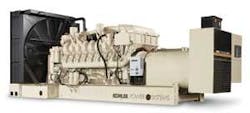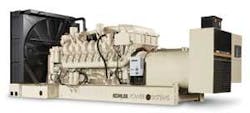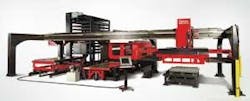Multiple laser system powers Kohler
Adding automated lasers allows complete environmental control
It was nearly 90 years ago, shortly after the end of World War I, when Kohler entered into the arena of electricity and power generation systems. Kohler recognized the growing demand for this technology and in 1920 produced the Kohler Automatic Power and Light “power plant.” This new design differed from all other power supply units in that it was able to produce 110V directly through power lines. It could also automatically turn on and off based on the demand for electricity. In comparison, the common generators of the time could produce only 32V and worked by charging a series of batteries.
The simplicity and reliability of this unit made it a favorite for commercial and industrial applications in areas that had yet to see any power lines. It was also used by Admiral Richard Byrd in his Antarctic expeditions in the 1920s and 1930s, and aided US troops in World War II.
This innovative unit and its success made Kohler Power Systems a leader in power generators. Kohler continued to grow through the 1950s and 1960s as it produced more powerful systems along with the advent of its diesel generator. Demand grew to supply backup power to hospitals, government facilities, and factories. Providing backup power to these institutions was yet another innovative move at that time because it had not yet been considered.
Kohler today
Today Kohler Power Systems provides power generators for the marine, residential, commercial, industrial/emergency, data backup, and mobile vehicle markets. The company manufactures generators with the capacity of supplying anywhere from 5kW to 2.8MW of power.
The Kohler manufacturing facility is located in Mosel, WI, close to Sheboygan. The 330,000 ft2 building operates 3 shifts per day and includes associates in production, engineering, marketing, and sales. Bill Hanmann, cell manager, Metal Processing Center, has been a part of keeping Kohler’s innovative spirit alive by responding to continuing growth demands. To be successful, Hanmann and his team have had to take a long look at lead times, outsourcing, and costs associated with their products.
The items causing the largest problem were the “skids” or generator frames (see Figure 1). According to Hanmann, Kohler was farming out more than 4000 skids per year. This factor alone was enough for Kohler and Hanmann to look to further increase their own productivity and improve the manufacturing process by taking more control of production.
Transitioning to automation
Kohler took more control of production by transitioning from its current method of manufacturing to an automated laser cell from Amada America Inc. Prior to the new laser cell, Kohler had run production as many shops do. It operated in a standalone environment with slower and older technology. Parts often went from one work station, into a work-in-progress (WIP) storage area, then to the next operation, only to return back to the WIP storage area. Kohler was fighting two large enemies of high production manufacturing: machine utilization and part throughput.
Kohler, not new to laser technology, was operating two older standalone lasers in its fabrication department. The company also did blanking on a shear and two standalone turret punch presses. According to Hanmann, Kohler would operate the two lasers with one operator per shift. The shear was manned on one shift, while the turrets ran three shifts. Also involved in this process were material handlers who were required to continuously move material and parts in and out of their vertical racking units and laborers who needed to perform some secondary metal finishing operations.
Kohler processes a wide variety of materials, from 0.25 in. to 18 gauge. The generator skids are predominantly made out of 7 and 10 gauge. A typical part will go through the blanking process to bending, welding, and then e-coat or powder coat process. The challenge that Kohler faced was how to streamline these processes in order to bring in the more than 4000 skids per year and still keep up with its current in-house production.
Thus, Kohler added an Amada fully automated three-laser system that included one raw material tower. However, two more challenges resulted from this decision. One was how to fit this system in the floor layout. Hanmann stated that the flexibility and modularity of the Amada system made that solution simple. The second issue was then how to implement all of this without interrupting current production.
In May 2007, Kohler took delivery of its first FO3015NT laser (see Figure 2). Then, in June, it removed one of the older standalone lasers and added the second FO3015NT. Finally, in July 2007, Kohler removed the second old standalone laser and added the third FO3015NT. The company then had the automation added, tying all three lasers together in one functioning cell, and by September 2007, Kohler was running at full steam. When asked how the transition went, Hanmann simply said, “very smoothly.”
Results: Increased production
The results, according to Hanmann, were almost immediate. The company accomplished its primary goal of being able to farm in all the skids. But more than that, they increased machine utilization with the automation and decreased lead times from five days to two days for the components previously run on the turrets. Capacity grew while WIP was virtually eliminated. The company was able to eliminate 20—30 sections of vertical racking used for storing raw material and WIP. Now, Kohler uses the tower system that is part of the automation to store the raw material that feeds the three lasers. The finished parts are no longer sent back into a tower, but instead are fed from the laser to flow conveyors, which send the parts immediately to the next process.
When asked how Kohler’s laser production has increased, Hanmann replied it has tripled in the short time this system has been running. What makes this even more impressive is that Kohler not only eliminated the two older standalone lasers, but it also eliminated the turrets and shear, moving most of the work from those machines to the new laser cell. Any components with formed features were moved to a new 50-ton punch laser. The edge quality has been flawless, so much that parts “always” go directly from the laser to the press brakes. Including the laser cell and punch laser, what was taking five workers per shift to accomplish in the past is now being done by two, Hanmann claims. By eliminating additional operators, material handlers, and secondary operations, Kohler achieved the ultimate goal of improving production capacity and quality and reducing lead time. Accomplishing this with fewer workers allowed the company to redistribute skilled labor to other areas of the facility.
Kohler and Hanmann, not satisfied with their accomplishments, are still pursuing even better ways to address their manufacturing needs. Kohler is in the process of implementing a new system that will further automate the creation of dynamic programs for the machines directly at the work centers by the operators themselves. “Hot” jobs can now be automatically inserted into production runs without even as much as a hiccup in the utilization of the laser cell.
Kohler Power Systems now has its sights set on new generators for new markets and more capacity. With the help of the Amada laser cell, it now has complete command of its manufacturing environment and its future.
Jason Hillenbrand ([email protected])is the national laser product manager forAmada America Inc. (www.amada.com),Buena Park, CA. Kohler Power’s web site is www.KohlerPower.com.


